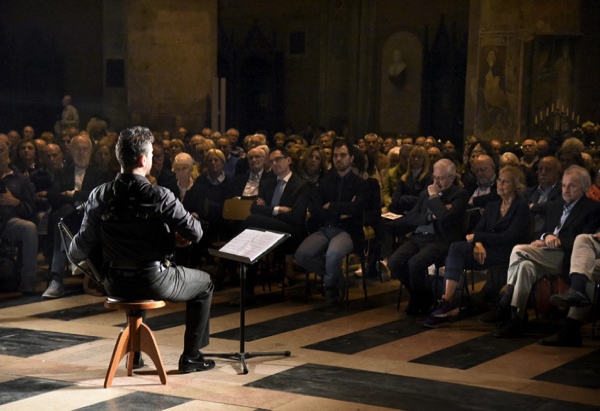Reviews

The accordion, an instrument that had to overcome old prejudices to impose its dignity and only now, thanks to your dedication and your work, is respected like any other concert instrument. The results you achieved are very important and I'm very glad to be aware of them.
Goffredo Petrassi, 1996
Beautiful and musical playing. Congratulations!
Ton Koopman, 2010
Excellent music, excellent playing.
Uri Caine, 2010
Jacomucci’s virtuosity is incredible and, sometimes, it’s difficult to believe that there are no more person playing other voices which seem to be impossible to do with two hands on this instrument. We have to point out the excellent use of dynamics of the bellows and the great musicality of this performer. Absolutely recommendable for any lover of the genius of Eisenach.
Ritmo Classic Music Magazine, Ignasi Jordà, 2010
Infernal Circles [by Claudio Jacomucci] deserves the palm for the best electroacustical composition with accordion ever heard.
Blowup Magazine, Michele Coralli, 2008
The contribution to musical performing has been given, besides the Scala's Orchestra and Choir, by some wellknown personalities such as Aldo Bennici, Claudio Jacomucci e Michele Lomuto : they were on scene as clowns (and nearly unrecognisable but to be admired for their virtuoso-bizarre performance) playing a tiny violin, the accordion and the trombone.
La Nazione, Leonardo Pinzauti, 1996
His instrument is a modern acustic accordion. He's skillful to deal with situations that intensify the fully instrumental dimension: maximum of dialectical contrasts of the dynamics, sudden jumps in the tonal range, intensification of breath and unpredictable agogics. In the accordion, there's always somethings that escape from our control: in Jacomucci's instrument, the complexity of its dimension take us beyond any knowledge to let us get into a world that is still waiting for a serious consideration by the contemporary music scene.
Altremusiche Magazine, Michele Coralli, 2004
Outre la Fugue BWV 539 et Passacaille et fugue, et trois Préludes et fugues extraits du Clavier bien tempéré, tous joués avec une techni- que irréprochable, nous entendons également trois chorals, dont l’in- terprétation reproduit la solennité et le recueillement religieux (no- tamment dans Erbarm dich mein et Ich Ruf zu dir). Les changements de sonorité en fonction des morceaux sont précisément dignes de grandes orgues. Jacomucci nous montre ainsi les immenses possibi- lités de cet instrument grâce à son art remarquable et son étonnante virtuosité.
RES Musique Classique, Victoria Okada, 2010
Unquestionably, the powerful musicality and the soft brilliance of the melancholy melodies which Jacomucci coaxes out of his instrument in your ears for a long time afterwards.
Basler Zeitung, 2000
Solid technique and sharp curiosity, Jacomucci overcomes the fences and notably modifies the physionomy of an instrument which is often relegated to prejudices.
Blowup Magazine, Piercarlo Poggio, 2003
The young musician has emphasized – with delicated but intense sensitivity – the strong peculiarity of the composition (Sonata n.2 by V.Zubitsky) together with a creative awareness that underlined every resource of the accordion. In De Profundis (S.Gubaidulina), Jacomucci has created, with intelligent precision, even the smallest nuance.
La Nuova Italia, 1992
The sound of his accordion kidnaps, upsets, gets inside. An unconventional timbre, more like that of an organ or an entire orchestra, an iridescent "voice", now warm and low like that of an oboe or a bassoon, now subtle and silky like the breath of a violin. His technique is very particular and refined. Lovely control. The repertoire is special. The passages dedicated to Bach are of overwhelming elegance, from the noble, solemn, visionary bearing and the swirling counterpoints of the "Fugue in D min BWV 539" to the abstract textures, the ostinato of the "Passacaglia BWV 582" to the pacifying "Contrapunctus XIV" from “The Art of Escape BWV 1080”. Dowland's play of colors is fascinating: “Lachrimae Antiquae”. But above all, his original compositions were stunned, capable of upsetting any idea of an accordion, from the tribal percussion of "Tarantolata" to the superb gloss on "Orfeo ed Euridice", a tribute to Monteverdi for accordion and recorded sounds, in practice a black hole, a magmatic beyond-space, crossed by Jacomucci also physically, traveling around and "on" the public, in which to sink without control. A noble, cathartic, exclusive, immersive, all-encompassing experience. There are not many concerts that leave this feeling.
Libertà, Pietro Corvi, 2017
What's striking about Jacomucci's Le Città Invisibili is the sonic environment, and in particular the timbral quality that catapults the listener into a little-known dimension, thanks to the specialty of the sounds. Technically, Jacomucci's work is not that of a virtuoso but of a researcher, and his involvement with sound and the organic organization of his investigations is impressive.
For me, Jacomucci's Le Città Invisibili is one of the high points of his artistic career.
Percorsi Musicali, Ettore Garzia, 2023 (about Le Città Invisibili)
Claudio Jacomucci is an experimenter, more out of an unstoppable expressive need than by artistic choice.
In Jacomucci, every city taken as a model (from Italo Calvino's "Invisible Cities") is a source of revitalization and innovation, experimental and expressive. Intelligently, Jacomucci doesn't attempt an impossible sonic representation of Calvino's text, but uses it as a starting point for an imaginative reinterpretation of the peculiarities of each city described in the novel.
The sonic spectrum of this music is truly fascinating. It's as if the instrument, from time to time, reclaims its real identity, becoming a city of real walls and streets, of living inhabitants and not a multifaceted chimera. But what we see is not a still photograph, a fixed expression, but the current and evolving life of the city that becomes music. In the sounds, we can imagine finding Fedora's glass globes, Valdrada's mirrors, Ersilia's woven threads; We have the right to be frightened by Octavia's peril over the abyss (that screech that sounds like a rope crumbling over the void, unraveling, and putting the staffs on our backs), or to be horrified by Eusapia's grotesque, overflowing Totentanz.
In my opinion, it is a masterpiece.
Musica magazine, Bernardo Pieri, 2023 (about Le Città Invisibili)